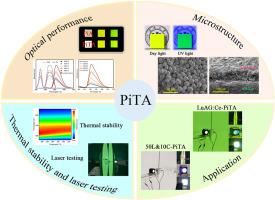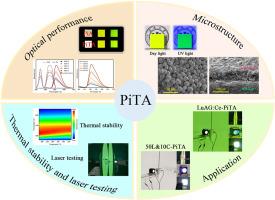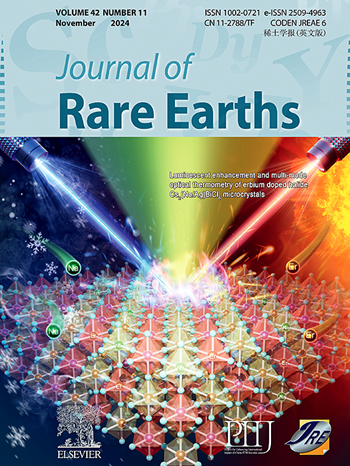通过引入TiO2,设计高反射率AlN复合衬底,合成用于高亮度反射激光照明的绿/白转换器☆
IF 7.2
1区 化学
Q1 CHEMISTRY, APPLIED
引用次数: 0
摘要
玻璃内磷(PiG)由于其工艺简单、颜色纯度高、颜色可调性好等优点,已被制备成各种类型的荧光粉薄膜。然而,现有的反射式pig薄膜在作为可靠的颜色转换器的稳定性和可行性方面遇到了限制,主要是由于热沉积和光学效率不足的问题。本文提出采用导热性能优越的AlN衬底包覆TiO2层,得到TiO2 - AlN (TA),增强蓝光反射率,促进光转换过程。通过在TA衬底上加入高热稳定性的LuAG:Ce-PiGs, LuAG:Ce-PiTA变换器的光通量为1102 W,在473 K时的相对强度为94.6%,这得益于其34.1 W/(m·K)的高导热系数。将CASN3:Eu添加到50lamp;10C-PiTA的颜色转换器中,可实现令人印象深刻的90.7的显色指数。LuAG:Ce-PiTA和50 L&;10C-PiTA的相对发光强度在反射激光模块24 h光照老化衰减测试中分别仅下降5.35%和3.28%。结果证实了优化设计的TA衬底适用于LuAG:Ce颜色转换器在高功率反射激光照明中的应用。本文章由计算机程序翻译,如有差异,请以英文原文为准。


Designing high-reflectivity AlN composite substrates by introduction of TiO2 to synthesize green/white converters for high-brightness reflective laser illumination☆
Phosphor-in-glass (PiG) has been prepared into various types of phosphor films owing to its simplicity process, exceptional color purity, and convenient color adjustability. Nevertheless, existing reflective PiGs films have encountered limitations in terms of stability and feasibility as reliable color converters, mainly attributed to issues related to thermal deposition and insufficient optical efficiency. Herein, we propose to use AlN substrate with superior thermal conductivity to coat the TiO2 layer to obtain TiO2–AlN (TA), which enhances the reflectivity of blue light to facilitate the light conversion process. By incorporating highly thermally stable LuAG:Ce-PiGs on a TA substrate, the LuAG:Ce-PiTA converter exhibits a luminous flux of 1102 [email protected] W, and maintains a relative intensity of 94.6% at 473 K benefiting from the high thermal conductivity of 34.1 W/(m·K). The addition of CASN3:Eu to the color converter 50 L&10C-PiTA enables an impressive CRI of 90.7. Relative luminescence intensities of LuAG:Ce-PiTA and 50 L&10C-PiTA only decrease by 5.35% and 3.28%, respectively, in the 24 h illumination aging decay test of the reflective laser module. The results confirm the suitability of the optimally designed TA substrate for LuAG:Ce color converter applications in high-power reflective laser illumination.
求助全文
通过发布文献求助,成功后即可免费获取论文全文。
去求助
来源期刊

Journal of Rare Earths
化学-应用化学
CiteScore
8.70
自引率
14.30%
发文量
374
审稿时长
1.7 months
期刊介绍:
The Journal of Rare Earths reports studies on the 17 rare earth elements. It is a unique English-language learned journal that publishes works on various aspects of basic theory and applied science in the field of rare earths (RE). The journal accepts original high-quality original research papers and review articles with inventive content, and complete experimental data. It represents high academic standards and new progress in the RE field. Due to the advantage of abundant RE resources of China, the research on RE develops very actively, and papers on the latest progress in this field emerge every year. It is not only an important resource in which technicians publish and obtain their latest research results on RE, but also an important way of reflecting the updated progress in RE research field.
The Journal of Rare Earths covers all research and application of RE rare earths including spectroscopy, luminescence and phosphors, rare earth catalysis, magnetism and magnetic materials, advanced rare earth materials, RE chemistry & hydrometallurgy, RE metallography & pyrometallurgy, RE new materials, RE solid state physics & solid state chemistry, rare earth applications, RE analysis & test, RE geology & ore dressing, etc.
 求助内容:
求助内容: 应助结果提醒方式:
应助结果提醒方式:


